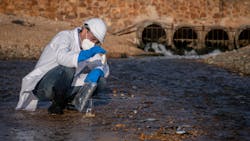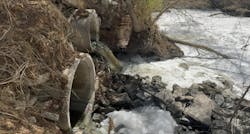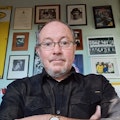U.S. Budget Cuts Stymie Cross-Border Chemical Pollution Research
“Without urgent interventions, communities on both sides of the border will continue to bear the health burden of this preventable crisis.”
That’s the conclusion of a recent study published in Science examining the effects of environmental water pollution on residents living near the U.S.-Mexico Tijuana River Valley border region.
Scientists from the University of California (UC) San Diego’s Scripps Institution of Oceanography, UC Riverside, San Diego State University and the National Science Foundation’s (NSF) National Center for Atmospheric Research studied a population that has endured nearly a century of environmental pollution, the impacts of which have escalated in recent years, according to the Science report.
A combination of industrial waste, harmful chemicals, untreated sewage and contaminated stormwater carried by the river empties into the Pacific Ocean at the southern edge of San Diego County. This includes millions of gallons of untreated industrial waste containing heavy metals and harmful chemicals released into the Tijuana River from maquiladoras — duty- and tariff-free manufacturing facilities — operating just south of the U.S.-Mexico border.
According to Mexicocrossborderfreight.com, over 3,200 maquiladoras operated in 2024, nearly 90% of them along this border zone. Distillation products ($27.5 billion), plastics ($12.4 billion) and rubber ($5 billion) were among their biggest exports.
Adding to the situation, intense atmospheric rivers in 2023 and 2024 damaged wastewater infrastructure on both sides of the border.
The study notes that the area’s deterioration led to its classification as an impaired water body under the U.S. Clean Water Act, with over 1,300 days of recent beach closures. The river itself ranked second in 2025’s America’s Most Endangered Rivers list.
However, despite community concerns, comprehensive air-quality measurements have never been made to identify the specific pollutants causing the malodors and adverse health effects, including respiratory and gastrointestinal issues, headaches, fatigue, skin infections, nausea and anxiety.
Something Smells Rotten
It turns out that the polluted river releases large quantities of the toxic gas hydrogen sulfide (H2S), notorious for its rotten egg smell.
The health effects of long-term exposure to the gas are not fully understood, but the California Office of Environmental Health Hazard Assessment sets a chronic exposure limit of 7.3 parts per billion (ppb). In contrast, the California Air Resources Board’s (CARB’s) one-hour standard is 30 ppb, a level based on odor, not health.
The three-week study, carried out last September, found H2S concentrations in the region’s South Bay peaked at 4,500 ppb for at least a minute and up to an average of 2,100 ppb for one hour — 70 times the CARB standard. For a 10-day period, residents in the San Diego neighborhood of Nestor, close to an elementary school, were exposed to levels of H2S more than CARB’s one-hour average air quality standard for between five and 14 hours each day.
The highest levels of hydrogen sulfide occurred at night, when winds usually die down.
Hundreds of other gases released into the air by the river and its ocean outflow were also identified as potential contributors to poor air quality across the region.
Resolution Suggestions
In terms of tackling the problem, the authors recommend immediate steps, such as activated carbon-based indoor air filtration to counter the peaks of H2S and other toxic gases, plus particulate filters to reduce exposure to aerosolized pollutants, including viruses, bacteria and fungal spores. This should be coupled with a community air-monitoring program and analysis, then ultimately a large-scale epidemiological study in the communities affected by the pollution.
One quick infrastructure action would be to eliminate the turbulent drop at the Saturn Boulevard site, where the largest source of H2S and other toxic gas emissions was identified (Figure 1).
To achieve this, the authors call for sustained monitoring, coordinated cross-border efforts and leadership from federal, state and local authorities.
“This study reveals a direct airborne pollutant exposure pathway — from contaminated rivers into the air we breathe,” said Kimberly Prather, the lead investigator of the study and an atmospheric chemist at UC San Diego’s Scripps Oceanography and the Department of Chemistry.
“For the first time, we’ve shown that poor water quality can profoundly degrade air quality, exposing entire communities to toxic gases and other pollutants. These findings validate the experiences of residents who have endured this crisis for decades and underscore the urgent need for action to protect public health in San Diego and in vulnerable communities worldwide,” she added.
Stalled Funding
However, cuts to NSF and National Oceanic and Atmospheric Administration budgets have stymied any ongoing research.
“There is no federal funding left on these projects, so we are using philanthropy. We are hoping things get calmer...then we will try to get them re-funded. However, we’re not sure when this will be possible,” Prather added, noting that a study with these findings would expect to qualify for further funding.
In another blow, the Balvi Philanthropic Foundation which helped fund the study says it is not accepting further research proposals.
About the Author
Seán Ottewell
Editor-at-Large
Seán Crevan Ottewell is Chemical Processing's Editor-at-Large. Seán earned his bachelor's of science degree in biochemistry at the University of Warwick and his master's in radiation biochemistry at the University of London. He served as Science Officer with the UK Department of Environment’s Chernobyl Monitoring Unit’s Food Science Radiation Unit, London. His editorial background includes assistant editor, news editor and then editor of The Chemical Engineer, the Institution of Chemical Engineers’ twice monthly technical journal. Prior to joining Chemical Processing in 2012 he was editor of European Chemical Engineer, European Process Engineer, International Power Engineer, and European Laboratory Scientist, with Setform Limited, London.
He is based in East Mayo, Republic of Ireland, where he and his wife Suzi (a maths, biology and chemistry teacher) host guests from all over the world at their holiday cottage in East Mayo.


